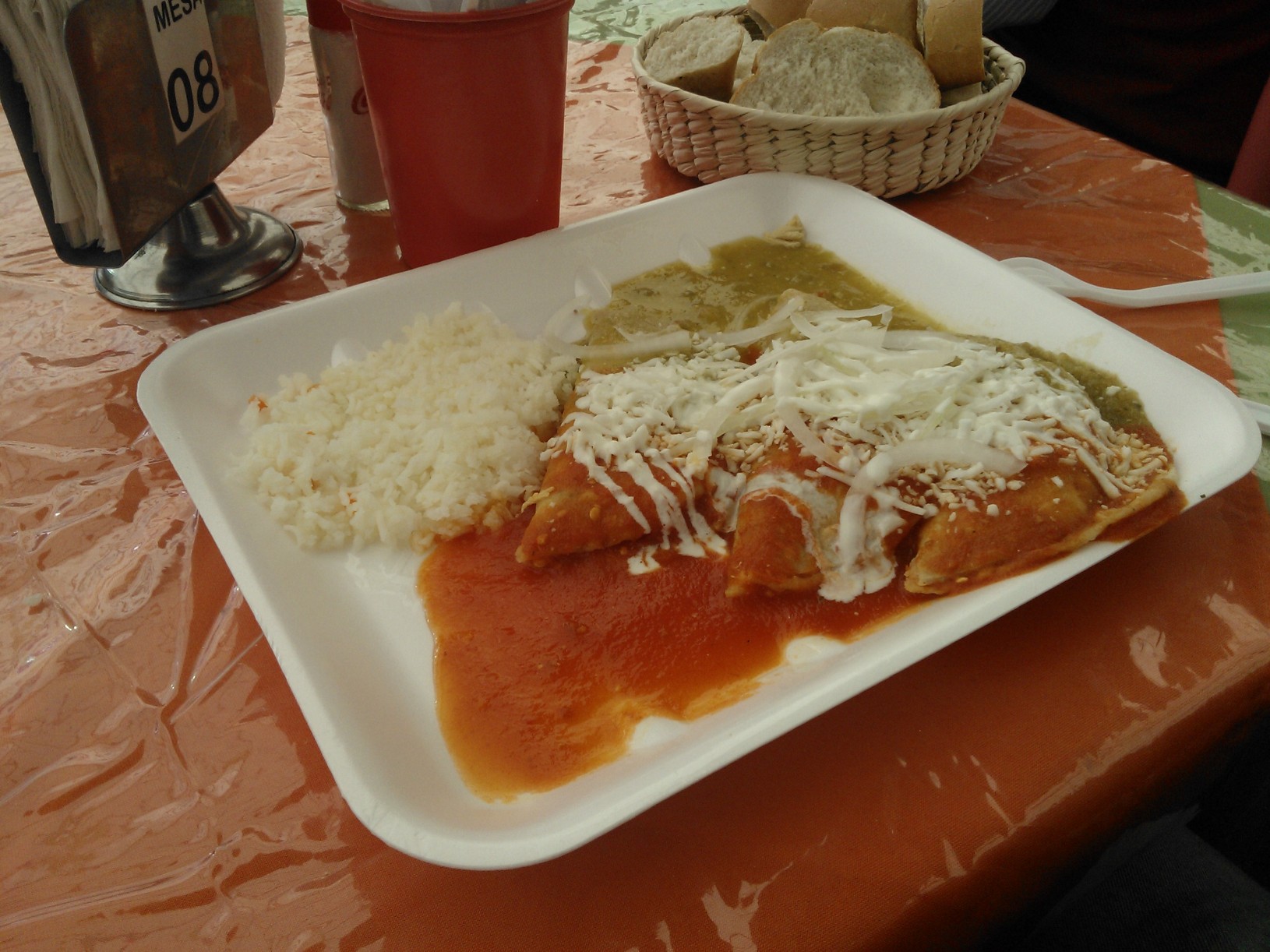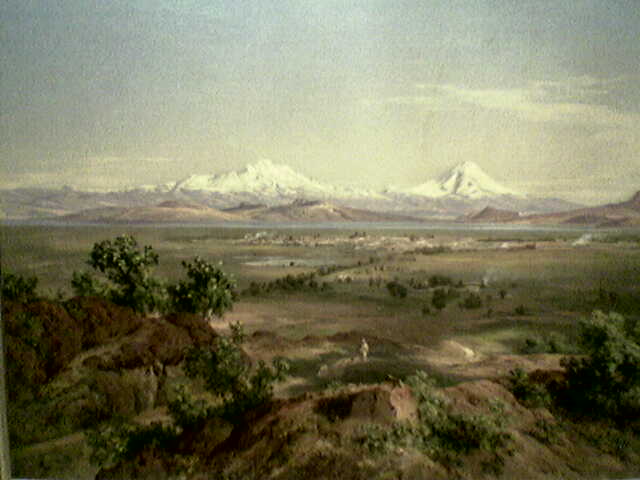|
Enchilada
An enchilada (, ) is a Mexican dish consisting of a corn tortilla rolled around a filling and covered with a savory sauce. Enchiladas can be filled with various ingredients, including meats, cheese, beans, potatoes, vegetables, or combinations. Enchilada sauces include chili-based sauces, such as salsa roja, various moles, tomatillo-based sauces, such as salsa verde, or cheese-based sauces, such as chile con queso. Etymology The Royal Spanish Academy defines the word ''enchilada'', as used in Mexico, as a rolled maize tortilla stuffed with meat and covered with a tomato and chili sauce. ''Enchilada'' is the past participle of Spanish ''enchilar'', "to add chili pepper to"; literally, "to season (or decorate) with chili". The idiomatic American English phrase "the whole enchilada" means "the whole thing". History Enchiladas originated in Mexico, where the practice of rolling tortillas around other food dates back at least to Aztec times. The people living in the lake region ... [...More Info...] [...Related Items...] OR: [Wikipedia] [Google] [Baidu] |
Corn Tortilla
In North America, a corn tortilla or just tortilla (, ) is a type of thin, unleavened flatbread, made from hominy, that is the whole kernels of maize treated with alkali to improve their nutrition in a process called nixtamalization. A simple dough made of ground, dried hominy, salt and water is then formed into flat discs and cooked on a very hot surface, generally an iron griddle called a comal. A similar flatbread from South America, called an '' arepa'' (though ''arepas'' are made with ground maize, not hominy, and are typically much thicker than tortillas), predates the arrival of Europeans to America, and was called ''tortilla'' by the Spanish from its resemblance to the traditional Spanish round, unleavened cakes and omelettes (originally made without potatoes, which are native to South America). The Aztecs and other Nahuatl-speakers call tortillas tlaxcalli (''Nahuatl Dictionary.'' (1997). Wired Humanities Project. University of Oregon. Retrieved August 29, 2012, frol ... [...More Info...] [...Related Items...] OR: [Wikipedia] [Google] [Baidu] |
Salsa Roja
Salsa roja () is a type of spicy red sauce in Mexican cuisine. It is made of jitomate (red tomato), ground with onion, garlic, chilli, salt and pepper to taste. This red sauce comes in subtypes: ''salsa cocida'' ("cooked sauce"), in which the ingredients are cooked (e.g. by stewing) and then ground; ''salsa asada'' ("roasted sauce"), in which the elements are roasted on a comal and then ground; '' salsa cruda'' ("raw sauce"), in which ingredients are ground raw, ready to eat; and a combination in which some elements are roasted and other cooked. A molcajete or a blender can be used for the grinding process. After the sauce is prepared, it can be cooked again in a pan with little oil. It is used to prepare traditional Mexican foods, in a mild spicy level for enchiladas and huevos rancheros, or spicier for antojitos such as tacos and quesadillas. See also * Chili sauce * Salsa verde * Pico de gallo * List of sauces The following is a list of notable culinary and prepare ... [...More Info...] [...Related Items...] OR: [Wikipedia] [Google] [Baidu] |
Mexican Cuisine
Mexican cuisine consists of the cooking cuisines and traditions of the modern country of Mexico. Its earliest roots lie in Mesoamerican cuisine. Its ingredients and methods begin with the first agricultural communities such as the Olmec and Maya who domesticated maize, created the standard process of maize nixtamalization, and established their foodways. Successive waves of other Mesoamerican groups brought with them their own cooking methods. These included: the Teotihuacanos, Toltec, Huastec, Zapotec, Mixtec, Otomi, Purépecha, Totonac, Mazatec, Mazahua, and Nahua. With the Mexica formation of the multi-ethnic Triple Alliance ( Aztec Empire), culinary foodways became infused (Aztec cuisine). Today's food staples native to the land include corn (maize), turkey, beans, squash, amaranth, chia, avocados, tomatoes, tomatillos, cacao, vanilla, agave, spirulina, sweet potato, cactus, and chili pepper. Its history over the centuries has resulted in regional cuisine ... [...More Info...] [...Related Items...] OR: [Wikipedia] [Google] [Baidu] |
Oxford University Press
Oxford University Press (OUP) is the university press of the University of Oxford. It is the largest university press in the world, and its printing history dates back to the 1480s. Having been officially granted the legal right to print books by decree in 1586, it is the second oldest university press after Cambridge University Press. It is a department of the University of Oxford and is governed by a group of 15 academics known as the Delegates of the Press, who are appointed by the vice-chancellor of the University of Oxford. The Delegates of the Press are led by the Secretary to the Delegates, who serves as OUP's chief executive and as its major representative on other university bodies. Oxford University Press has had a similar governance structure since the 17th century. The press is located on Walton Street, Oxford, opposite Somerville College, in the inner suburb of Jericho. For the last 500 years, OUP has primarily focused on the publication of pedagogical texts a ... [...More Info...] [...Related Items...] OR: [Wikipedia] [Google] [Baidu] |
American English
American English, sometimes called United States English or U.S. English, is the set of varieties of the English language native to the United States. English is the most widely spoken language in the United States and in most circumstances is the de facto common language used in government, education and commerce. Since the 20th century, American English has become the most influential form of English worldwide. American English varieties include many patterns of pronunciation, vocabulary, grammar and particularly spelling that are unified nationwide but distinct from other English dialects around the world. Any American or Canadian accent perceived as lacking noticeably local, ethnic or cultural markers is popularly called "General" or "Standard" American, a fairly uniform accent continuum native to certain regions of the U.S. and associated nationally with broadcast mass media and highly educated speech. However, historical and present linguistic evidence does not sup ... [...More Info...] [...Related Items...] OR: [Wikipedia] [Google] [Baidu] |
Aztec Civilization
The Aztecs () were a Mesoamerican culture that flourished in central Mexico in the post-classic period from 1300 to 1521. The Aztec people included different ethnic groups of central Mexico, particularly those groups who spoke the Nahuatl language and who dominated large parts of Mesoamerica from the 14th to the 16th centuries. Aztec culture was organized into city-states (''altepetl''), some of which joined to form alliances, political confederations, or empires. The Aztec Empire was a confederation of three city-states established in 1427: Tenochtitlan, city-state of the Mexica or Tenochca; Texcoco; and Tlacopan, previously part of the Tepanec empire, whose dominant power was Azcapotzalco. Although the term Aztecs is often narrowly restricted to the Mexica of Tenochtitlan, it is also broadly used to refer to Nahua polities or peoples of central Mexico in the prehispanic era, as well as the Spanish colonial era (1521–1821). The definitions of Aztec and Aztecs have lon ... [...More Info...] [...Related Items...] OR: [Wikipedia] [Google] [Baidu] |
Valley Of Mexico
The Valley of Mexico ( es, Valle de México) is a highlands plateau in central Mexico roughly coterminous with present-day Mexico City and the eastern half of the State of Mexico. Surrounded by mountains and volcanoes, the Valley of Mexico was a centre for several pre-Columbian civilizations, including Teotihuacan, the Toltec, and the Aztec. The ancient Aztec term ('Land Between the Waters') and the phrase Basin of Mexico are both used at times to refer to the Valley of Mexico. The Basin of Mexico became a well known site that epitomized the scene of early Classic Mesoamerican cultural development as well. The Valley of Mexico is located in the Trans-Mexican Volcanic Belt. The valley contains most of the Mexico City Metropolitan Area, as well as parts of the State of Mexico, Hidalgo, Tlaxcala, and Puebla. The Basin of Mexico covers approximately in the NNE-SSW direction with length to width dimensions of approximately to The Valley of Mexico can be subdivided into f ... [...More Info...] [...Related Items...] OR: [Wikipedia] [Google] [Baidu] |
Bernal Díaz Del Castillo
Bernal Díaz del Castillo ( 1492 – 3 February 1584) was a Spanish conquistador, who participated as a soldier in the conquest of the Aztec Empire under Hernán Cortés and late in his life wrote an account of the events. As an experienced soldier of fortune, he had already participated in expeditions to Tierra Firme, Cuba, and to Yucatán before joining Cortés. In his later years he was an encomendero and governor in Guatemala where he wrote his memoirs called ''The True History of the Conquest of New Spain''. He began his account of the conquest almost thirty years after the events and later revised and expanded it in response to the biography published by Cortés's chaplain Francisco López de Gómara, which he considered to be largely inaccurate in that it did not give due recognition to the efforts and sacrifices of others in the Spanish expedition. Early life Bernal Díaz was born in the year 1492 in Medina del Campo, a prosperous commercial city in Castile. His ... [...More Info...] [...Related Items...] OR: [Wikipedia] [Google] [Baidu] |
Mole (sauce)
Mole, from Nahuatl mōlli (), meaning "sauce", is a traditional sauce and marinade originally used in Mexican cuisine. In contemporary Mexico the term is used for a number of sauces, some quite dissimilar, including mole amarillo or amarillito (yellow mole), mole chichilo, mole colorado or coloradito (reddish mole), mole manchamantel or manchamanteles (tablecloth stainer), mole negro (black mole), mole rojo (red mole), mole verde (green mole), mole poblano, mole almendrado (mole with almond), mole michoacano, mole prieto, mole ranchero, mole tamaulipeco, mole xiqueno, mole pipián (mole with squash seed), mole rosa (pink mole), mole blanco (white mole), chimole, guacamole (mole with avocado) and huaxmole (mole with huaje). Generally, a mole sauce contains fruits, nuts, chili peppers, and spices like black pepper, cinnamon, or cumin. While not moles in the classic sense, there are some dishes that use the term in their name. Mole de olla is a stew made from beef and vegeta ... [...More Info...] [...Related Items...] OR: [Wikipedia] [Google] [Baidu] |
Chili Pepper
Chili peppers (also chile, chile pepper, chilli pepper, or chilli), from Nahuatl '' chīlli'' (), are varieties of the berry-fruit of plants from the genus '' Capsicum'', which are members of the nightshade family Solanaceae, cultivated for their pungency. Chili peppers are widely used in many cuisines as a spice to add "heat" to dishes. Capsaicin and related compounds known as capsaicinoids are the substances giving chili peppers their intensity when ingested or applied topically. While ''chili peppers'' are (to varying degrees) pungent or "spicy", there are other varieties of capsicum such as bell peppers (UK: peppers) which generally provide additional sweetness and flavor to a meal rather than “heat.” Chili peppers are believed to have originated somewhere in Central or South America. and were first cultivated in Mexico. After the Columbian Exchange, many cultivars of chili pepper spread around the world, used for both food and traditional medicine. This led ... [...More Info...] [...Related Items...] OR: [Wikipedia] [Google] [Baidu] |
Hernán Cortés
Hernán Cortés de Monroy y Pizarro Altamirano, 1st Marquess of the Valley of Oaxaca (; ; 1485 – December 2, 1547) was a Spanish '' conquistador'' who led an expedition that caused the fall of the Aztec Empire and brought large portions of what is now mainland Mexico under the rule of the King of Castile in the early 16th century. Cortés was part of the generation of Spanish explorers and conquistadors who began the first phase of the Spanish colonization of the Americas. Born in Medellín, Spain, to a family of lesser nobility, Cortés chose to pursue adventure and riches in the New World. He went to Hispaniola and later to Cuba, where he received an '' encomienda'' (the right to the labor of certain subjects). For a short time, he served as ''alcalde'' (magistrate) of the second Spanish town founded on the island. In 1519, he was elected captain of the third expedition to the mainland, which he partly funded. His enmity with the Governor of Cuba, Diego Velázquez de Cuél ... [...More Info...] [...Related Items...] OR: [Wikipedia] [Google] [Baidu] |




.jpg)



